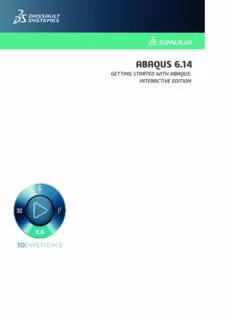Table Of ContentGetting Started with Abaqus: Interactive Edition
ABAQUS 6.14
GETTING STARTED WITH ABAQUS:
INTERACTIVE EDITION
Abaqus ID:
Printedon:
Getting Started with Abaqus
Interactive Edition
Abaqus ID:
Printedon:
Legal Notices
CAUTION:ThisdocumentationisintendedforqualifieduserswhowillexercisesoundengineeringjudgmentandexpertiseintheuseoftheAbaqus
Software.TheAbaqusSoftwareisinherentlycomplex,andtheexamplesandproceduresinthisdocumentationarenotintendedtobeexhaustiveortoapply
toanyparticularsituation.Usersarecautionedtosatisfythemselvesastotheaccuracyandresultsoftheiranalyses.
DassaultSystèmesanditssubsidiaries,includingDassaultSystèmesSimuliaCorp.,shallnotberesponsiblefortheaccuracyorusefulnessofanyanalysis
performedusingtheAbaqusSoftwareortheprocedures,examples,orexplanationsinthisdocumentation.DassaultSystèmesanditssubsidiariesshallnot
beresponsiblefortheconsequencesofanyerrorsoromissionsthatmayappearinthisdocumentation.
TheAbaqusSoftwareisavailableonlyunderlicensefromDassaultSystèmesoritssubsidiaryandmaybeusedorreproducedonlyinaccordancewiththe
termsofsuchlicense.Thisdocumentationissubjecttothetermsandconditionsofeitherthesoftwarelicenseagreementsignedbytheparties,or,absent
suchanagreement,thethencurrentsoftwarelicenseagreementtowhichthedocumentationrelates.
Thisdocumentationandthesoftwaredescribedinthisdocumentationaresubjecttochangewithoutpriornotice.
NopartofthisdocumentationmaybereproducedordistributedinanyformwithoutpriorwrittenpermissionofDassaultSystèmesoritssubsidiary.
TheAbaqusSoftwareisaproductofDassaultSystèmesSimuliaCorp.,Providence,RI,USA.
©DassaultSystèmes,2014
Abaqus,the3DSlogo,SIMULIA,CATIA,andUnifiedFEAaretrademarksorregisteredtrademarksofDassaultSystèmesoritssubsidiariesintheUnited
Statesand/orothercountries.
Othercompany,product,andservicenamesmaybetrademarksorservicemarksoftheirrespectiveowners. Foradditionalinformationconcerning
trademarks,copyrights,andlicenses,seetheLegalNoticesintheAbaqus6.14InstallationandLicensingGuide.
Abaqus ID:
Printedon:
CONTENTS
Contents
1. Introduction
The Abaqus products 1.1
GettingstartedwithAbaqus 1.2
Abaqus documentation 1.3
Getting help 1.4
Support 1.5
Aquickreviewofthefiniteelementmethod 1.6
Getting Started 1.7
2. Abaqus Basics
ComponentsofanAbaqusanalysismodel 2.1
IntroductiontoAbaqus/CAE 2.2
Example: creatingamodelofanoverheadhoist 2.3
Comparisonofimplicitandexplicitprocedures 2.4
Summary 2.5
3. Finite Elements and Rigid Bodies
Finite elements 3.1
Rigid bodies 3.2
Summary 3.3
4. Using Continuum Elements
Elementformulationandintegration 4.1
Selectingcontinuum elements 4.2
Example: connectinglug 4.3
Meshconvergence 4.4
RelatedAbaqusexamples 4.5
Suggested reading 4.6
Summary 4.7
5. Using Shell Elements
Elementgeometry 5.1
Shellformulation–thickorthin 5.2
Shellmaterialdirections 5.3
Selectingshellelements 5.4
Example: skew plate 5.5
i
Abaqus ID:gsa-toc
Printed on: Sun March 9 -- 17:32:14 2014
CONTENTS
RelatedAbaqusexamples 5.6
Suggested reading 5.7
Summary 5.8
6. Using Beam Elements
Beam cross-sectiongeometry 6.1
Formulationandintegration 6.2
Selectingbeam elements 6.3
Example: cargocrane 6.4
RelatedAbaqusexamples 6.5
Suggested reading 6.6
Summary 6.7
7. Linear Dynamics
Introduction 7.1
Damping 7.2
Elementselection 7.3
Meshdesignfordynamics 7.4
Example: cargocraneunderdynamicloading 7.5
Effectofthenumberofmodes 7.6
Effectofdamping 7.7
Comparisonwithdirecttimeintegration 7.8
Otherdynamicprocedures 7.9
RelatedAbaqusexamples 7.10
Suggested reading 7.11
Summary 7.12
8. Nonlinearity
Sources ofnonlinearity 8.1
Thesolutionofnonlinearproblems 8.2
IncludingnonlinearityinanAbaqusanalysis 8.3
Example: nonlinearskewplate 8.4
RelatedAbaqusexamples 8.5
Suggested reading 8.6
Summary 8.7
9. Nonlinear Explicit Dynamics
TypesofproblemssuitedforAbaqus/Explicit 9.1
Explicitdynamicfiniteelementmethods 9.2
Automatictimeincrementationandstability 9.3
Example: stresswavepropagationinabar 9.4
ii
Abaqus ID:gsa-toc
Printed on: Sun March 9 -- 17:32:14 2014
CONTENTS
Dampingofdynamicoscillations 9.5
Energy balance 9.6
Summary 9.7
10. Materials
DefiningmaterialsinAbaqus 10.1
Plasticityinductile metals 10.2
Selectingelementsforelastic-plasticproblems 10.3
Example: connectinglugwithplasticity 10.4
Example: blastloadingonastiffenedplate 10.5
Hyperelasticity 10.6
Example: axisymmetricmount 10.7
Meshdesignforlargedistortions 10.8
Techniquesforreducingvolumetriclocking 10.9
RelatedAbaqusexamples 10.10
Suggested reading 10.11
Summary 10.12
11. Multiple Step Analysis
Generalanalysisprocedures 11.1
Linearperturbationanalysis 11.2
Example: vibrationofapipingsystem 11.3
Restartanalysis 11.4
Example: restartingthepipevibrationanalysis 11.5
RelatedAbaqusexamples 11.6
Summary 11.7
12. Contact
OverviewofcontactcapabilitiesinAbaqus 12.1
Definingsurfaces 12.2
Interactionbetweensurfaces 12.3
DefiningcontactinAbaqus/Standard 12.4
ModelingissuesforrigidsurfacesinAbaqus/Standard 12.5
Abaqus/Standard2Dexample: formingachannel 12.6
GeneralcontactinAbaqus/Standard 12.7
Abaqus/Standard3Dexample: shearingofalapjoint 12.8
DefiningcontactinAbaqus/Explicit 12.9
ModelingconsiderationsinAbaqus/Explicit 12.10
Abaqus/Explicitexample: circuitboarddroptest 12.11
CompatibilitybetweenAbaqus/StandardandAbaqus/Explicit 12.12
RelatedAbaqusexamples 12.13
iii
Abaqus ID:gsa-toc
Printed on: Sun March 9 -- 17:32:14 2014
CONTENTS
Suggested reading 12.14
Summary 12.15
13. Quasi-StaticAnalysiswith Abaqus/Explicit
Analogyforexplicitdynamics 13.1
Loading rates 13.2
Mass scaling 13.3
Energy balance 13.4
Example: formingachannelinAbaqus/Explicit 13.5
Summary 13.6
A. Example Files
Overheadhoistframe A.1
Connecting lug A.2
Skew plate A.3
Cargo crane A.4
Cargocrane–dynamicloading A.5
Nonlinearskew plate A.6
Stresswavepropagationinabar A.7
Connectinglugwithplasticity A.8
Blastloadingonastiffenedplate A.9
Axisymmetric mount A.10
Vibrationofapipingsystem A.11
Forming a channel A.12
Shearingofa lapjoint A.13
Circuitboarddroptest A.14
B. CreatingandAnalyzingaSimpleModelinAbaqus/CAE
UnderstandingAbaqus/CAEmodules B.1
UnderstandingtheModelTree B.2
Creating a part B.3
Creating a material B.4
Definingandassigningsectionproperties B.5
Assemblingthemodel B.6
Definingyouranalysissteps B.7
Applyingaboundaryconditionandaloadtothemodel B.8
Meshingthe model B.9
Creatingandsubmittingananalysisjob B.10
Viewingtheresultsofyouranalysis B.11
Summary B.12
iv
Abaqus ID:gsa-toc
Printed on: Sun March 9 -- 17:32:14 2014
CONTENTS
C. UsingAdditionalTechniquestoCreateandAnalyzeaModelinAbaqus/CAE
Overview C.1
Creatingthe firsthinge piece C.2
Assigningsectionpropertiestothehingepart C.3
Creatingandmodifyingasecondhingepiece C.4
Creating the pin C.5
Assemblingthemodel C.6
Defininganalysis steps C.7
Creatingsurfacestouseincontactinteractions C.8
Definingcontactbetweenregionsofthemodel C.9
Applyingboundaryconditionsandloadstotheassembly C.10
Meshingtheassembly C.11
Creatingandsubmittingajob C.12
Viewingtheresultsofyouranalysis C.13
Summary C.14
D. Viewing theOutput from YourAnalysis
Overview D.1
Whichvariablesareintheoutputdatabase? D.2
Readingtheoutputdatabase D.3
Customizinga modelplot D.4
Displayingthedeformedmodelshape D.5
Displayingandcustomizingacontourplot D.6
Animatinga contourplot D.7
Displayingandcustomizingasymbolplot D.8
Displayingandcustomizingamaterialorientationplot D.9
DisplayingandcustomizinganX–Yplot D.10
OperatingonX–Ydata D.11
Probing anX–Yplot D.12
Displayingresultsalongapath D.13
Summary D.14
E. Flow through a bent tube
Overview E.1
Creatingthemodelforthefluidflowanalysis E.2
CreatingaCFDanalysisjobforthefluidflowanalysis E.3
RunningandmonitoringtheCFDanalysis E.4
ViewingtheCFDanalysisresults E.5
Creatingthefluidmodelforthefluid-structureinteractionanalysis E.6
Creatingthestructuralmodelforthefluid-structureinteractionanalysis E.7
Creatingaco-simulationjobforthefluid-structureinteractionanalysis E.8
v
Abaqus ID:gsa-toc
Printed on: Sun March 9 -- 17:32:14 2014
CONTENTS
Runningandmonitoringthefluid-structureco-simulationanalysis E.9
Viewingthefluid-structureco-simulationanalysisresults E.10
vi
Abaqus ID:gsa-toc
Printed on: Sun March 9 -- 17:32:14 2014
Description:A brief introduction to using Abaqus/CFD is included as an appendix would be typed on your computer to run Abaqus/CAE. publications are available from SIMULIA through the Abaqus HTML documentation and in PDF . interfaces and custom programming techniques not discussed in this guide:.

